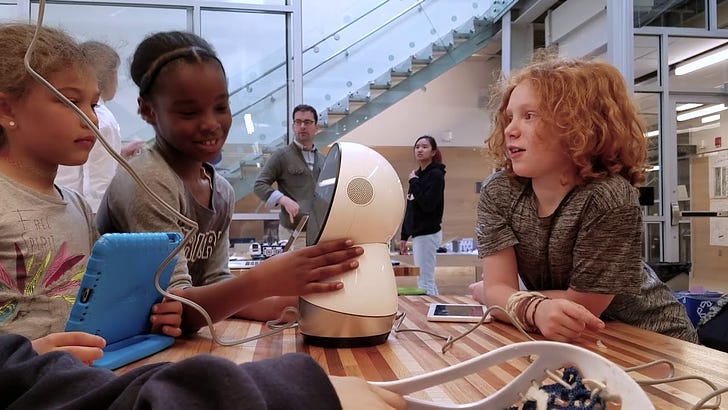AI on the brain
AI is a hot topic—mostly in the form of ChatGPT and its many cousins—as students and teachers head back to the classroom and campus. School districts like New York City Public Schools that initially banned ChatGPT are now pivoting 180 to “embrace” generative AI. Los Angeles Unified School District is still restricting it but the superintendent, Alberto M. Carvalho, claims they’re working on a “more permissive policy” according to Aug. 24 reporting in the New York Times.
Reading the daily coverage in a wide range of media, it’s easy to get the mistaken idea that no one saw this coming. But researchers and educators have been doing visionary foundational work supporting AI literacy for young people for several years now. One of the researchers whose creative projects have inspired me for some time is Stefania Druga.
Stefania Druga works in a lineage that flows directly from Seymour Papert to Mitch Reznick. She was a LEGO Papert Fellow during her time as a master student at MIT, researching with Mitch Resnick and the Scratch team.
While working in the Personal Robots Group at the MIT Media Lab, she created Cognimates as an open source platform for AI literacy for children 7-14 years old.
This video is from October, 2018.
For Stefania’s in-depth account of her path to creating Cognimates, give this post a read. It’s a great story, rich with details and history.
And for a deep dive, I recommend this video of Stefania talking about Cognimates in 2018. It’s an hour long, well worth the time. She shows you Cognimates at work— you’ll have a much better idea of what you can do with it.
Or go straight to the Cognimates site and start playing.
Elsewhere on Substack
Ethan Mollick, professor at the Wharton School of the University of Pennsylvania, writes the One Useful Thing stack. His post “Now is the time for grimoires” is a great read. Here’s an excerpt:
With the rise of a new form of AI, the Large Language Model, organizations continue to think that whoever controls the data is going to win. But at least in the near future, I not only think they are wrong, but also that this approach blinds them to the most useful thing that they (and all of us), can be doing in this AI-haunted moment: creating grimoires, spellbooks full of prompts that encode expertise.
He offers really clear guidance on how to create prompt spellbooks for learning. This is a great piece to share, discuss, and try with students, colleagues, your teenager, team members.
In the Wilds
Turning the tide on species loss with long term thinking
Ryan Phelan speaks about bringing biotech to wildlife conservation at the Long Now Foundation, April 2023. Ryan is Executive Director of Revive & Restore, a wildlife conservation organization promoting the incorporation of biotechnologies into standard conservation practice. Phelan shares the new Genetic Rescue Toolkit for conservation—”a suite of biotechnology tools and conservation applications that offer hope and a path to recovery for threatened species.” She discusses her organization’s work with US Fish & Wildlife Service on a “genetic rescue” of the black-footed ferret. (You’ll meet Elizabeth Ann.)
Other examples include their collaboration with Mary Hagedorn, a senior research scientist at the Smithsonian working on the cryopreservation of corals, and a project reintroducing the sunflower seastar to California.
Keywords include: biobanking, biodiversity, cryopreservation, de-extinction, San Diego Frozen Zoo. Thanks to a reader and Long Now fan for sharing this with me.
Conservation Celebration
Unlocking a river: rare silver fish returns to its ancient spawning grounds: a great photo essay in The Guardian on the twaite shad, a member of the herring family, and the Severn estuary in the UK
People are understanding that rivers are important and they are worth protecting. —Corinne Spiller, Unlocking the Severn
Here’s an excerpt (but don’t miss the stunning photos):
“The project, completed in 2022, has allowed the once abundant fish to return to its natural spawning grounds in the Severn for the first time in more than 180 years. A series of navigational weirs built in the mid-19th century had been preventing access to more than 150 miles of river until UTS built four fish passes—a series of imposing partially submerged concrete monoliths—into the weirs, giving hope to many of the Severn’s beleaguered fish species.”
In Memoriam
The Bellingshausen Sea populations of Emperor penguins—up to 10,000 young birds
From the Photo Ark database. Video by Joel Sartore.
I didn’t want to click on this link in the BBC. The post is titled: Climate change: Thousands of penguins die in Antarctic ice breakup. I’d noticed a headline about penguins earlier in the day as I scanned the NYT. I went right past it. So when I saw this one, I remembered my commitment to a practice I think of as “Turning Toward.” I clicked the link. I’m glad I clicked the BBC post. It’s more detailed than the NYT post which I did return to later…BBC Science correspondent Jonathan Amos helps you to really visualize the event—through a series of graphics including “How the Emperor penguin breeding cycle depends on sea-ice.” And he gives readers a view through the eye of the EU’s Copernicus Sentinel-2 satellite.
The BBC post reports:
Currently, emperors are classified as "Near Threatened" by the International Union for Conservation of Nature (IUCN), the organisation that keeps the lists of Earth's most endangered animals.
A proposal has been made to lift emperors into the more urgent "Vulnerable" category because of the danger posed by climate warming to their way of life.
I think only when we viscerally understand how sea ice loss is dramatically and rapidly impacting species like the Bellingshausen Sea populations of Emperor penguins can we see how critical it is to act in whatever ways we can.
Thanks for reading. Be well. Turn toward.


